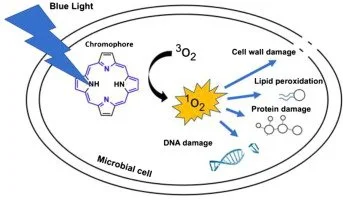Shining a (blue) light on health: Exploring the benefits of blue light phototherapy for dogs and horses
For many, blue light remains a bit of a mystery. Often (we’d argue, unfairly) discounted as ineffective, in fact, blue light has its own, unique superpower.
So, what is Blue Light Phototherapy?
Blue light therapy, also known as photobiomodulation, involves exposing the skin to specific wavelengths of blue light. At wavelengths of 400-470nm it is intrinsically antimicrobial and effective at bacteria reduction.
So, in a world where both people and pets are becoming increasingly drug resistant, it’s another tool in our toolbox for helping animals stay healthy
How does it work? (the science bit!)
The application of antimicrobial blue light causes what’s known as ‘photoexcitation’ of photosensitisers: photosensitisers are agents that absorb light of a specific wavelength and transform it into useful energy.
Source: Antimicrobial blue light: A ‘Magic Bullet’ for the 21st century and beyond?
Science Direct | Advanced Drug Delivery Reviews | Volume 180, January 2022, 114057
This photoexcitation leads to the release of reactive oxygen species (ROS) and these oxidative molecules have the power to ‘inactivate’ some fungal and viral pathogens and, multidrug-resistant bacteria as well as bacterial biofilms.
And THAT means they’re good at killing the pathogens found in food processing and on your kitchen worktop; decontaminating services in clinical environments and, most importantly for us, killing bacteria on the surface of wounds without damaging surrounding healthy skin.
Benefits for Dogs:
For wound healing: Blue light has been shown to accelerate wound healing by stimulating cell proliferation and reducing inflammation. This can be particularly helpful for dogs with hot spots, lick granulomas, or surgical wounds.
For skin conditions: Blue light's antimicrobial properties can be beneficial for treating bacterial and some fungal skin infections, like pyoderma (bacterial skin infections, or impetigo)
For dental care: Blue light is particularly effective for killing bacteria on the teeth or gums and can form part of an effective veterinary dental care regime.
Benefits for Horses:
For skin and wound healing: Just as for dogs, blue light can promote wound healing and reduce inflammation in horses, aiding recovery from injury. Use Lumina blue light prior to red light to create the optimal conditions for recovery.
Seasonal coat management: Blue light therapy can help regulate melatonin production, delaying winter coat growth and shedding. This can be helpful for horses prone to overheating or those competing in warmer climates.
Management of pituitary pars intermedia dysfunction (PPID): Researchers at University College Dublin are now working with the University of Kentucky’s Gluck Equine Research Centre on a 12-month study into the effects of blue light on PPID (equine cushing’s disease). We’ll be following their progress with interest.
Important considerations:
Blue light therapy can form part of an effective treatment regime for wounds and skin conditions. Always speak to your vet before commencing any treatment and, with their permission, be sure to select a phototherapy device that delivers the correct wavelength and dose. Treatment duration and frequency will vary depending on the condition and the power the device itself delivers. Follow your veterinarian's instructions carefully!
Disclaimer: This blog is for informational purposes only and does not replace the advice of your veterinarian and the wider veterinary team.
Reference Resources:
https://www.frontiersin.org/articles/10.3389/fmed.2022.905606/full
https://www.sciencedirect.com/science/article/abs/pii/S0169409X21004506
Gluck Equine Research Centre and University College Dublin study: https://gluck.ca.uky.edu/

